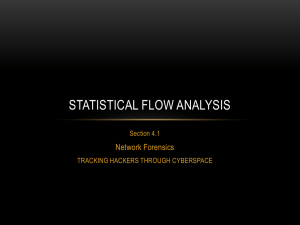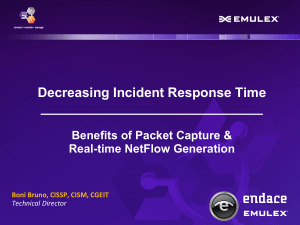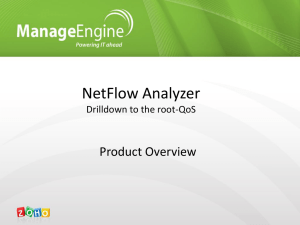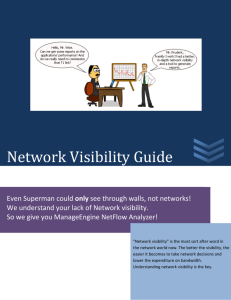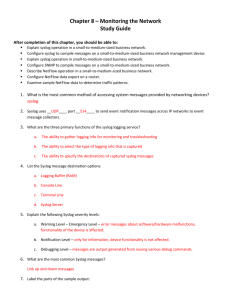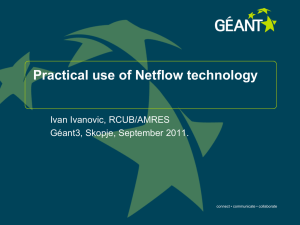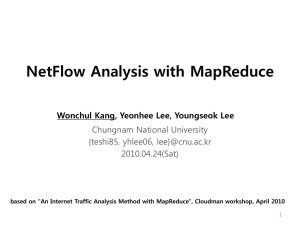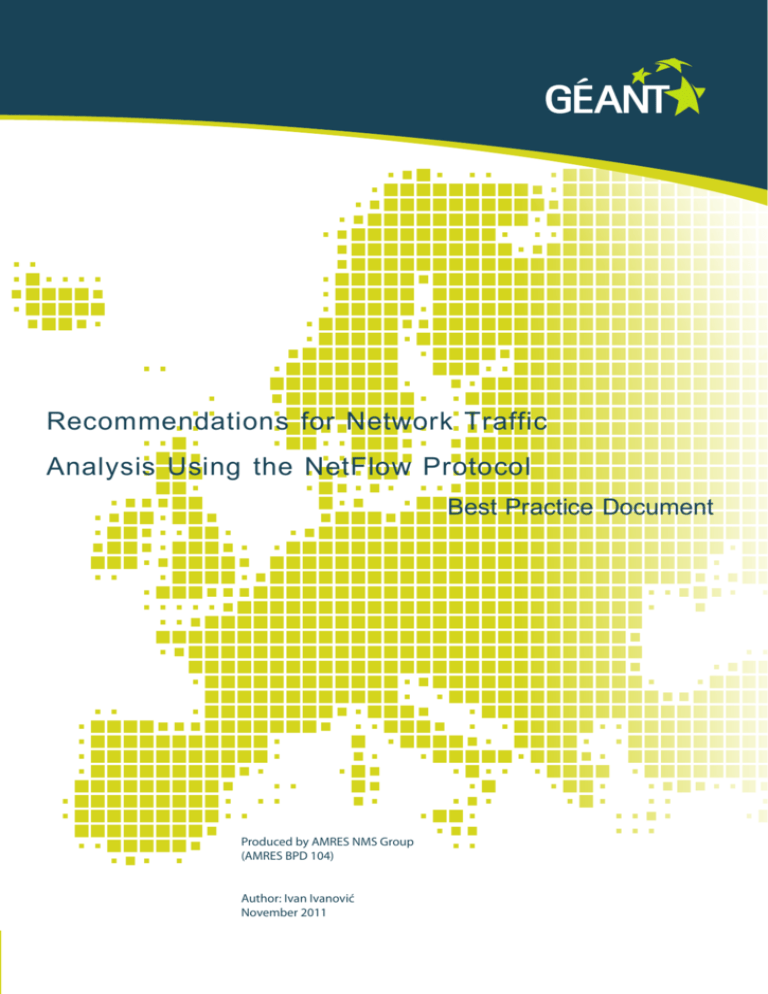
Recommendations for Network Traffic
Analysis Using the NetFlow Protocol
Best Practice Document
Produced by AMRES NMS Group
(AMRES BPD 104)
Author: Ivan Ivanović
November 2011
© TERENA 2010. All rights reserved.
Document No:
Version / date:
Source language
Original title:
Original version / date:
Contact:
GN3-NA3-T4-AMRES-BPD-104
November 2011
Serbian
“Preporuka za analizu mrežnog saobraćaja pomoću NetFlow protokola”
Revision 1 (of the document dated September 2010) / 11 November 2011
ivan.ivanovic@rcub.bg.ac.rs
AMRES/RCUB is responsible for the contents of this document. The document was developed by the NMS Group
organised by AMRES with the purpose of implementing joint activities on the development and dissemination of documents
containing technical guidelines and recommendations for network services in higher education and research institutions in
Serbia.
Parts of this document may be freely copied, unaltered, provided that their original source is acknowledged and the
copyright preserved.
The research leading to these results has received funding from the European Community’s Seventh Framework
Programme (FP7/2007-2013) under grant agreement n° 238875, relating to the project ‘Multi-Gigabit European Research
and Education Network and Associated Services (GN3)’.
2
Table of Contents
Executive Summary
4
Introduction
5
1
Network Traffic Analysis
6
1.1
6
An Overview of the Technologies Applied in Network Traffic Analysis
1.1.1 Advantages and Shortcomings of the Analysis of Exported NetFlow
Statistics
7
2
1.2
The Architecture of the NetFlow Statistics Analysis System
8
1.3
The Location of the NetFlow Collector in the Network
9
Configuring the NetFlow Exporter
10
2.1
Group I – Only the Central Device Supports the NetFlow Technology
10
2.2
Group II – Devices at the Edge of the Network Support the NetFlow Technology
12
2.3
Group III – Duplication of Traffic
12
3
Exporting the NetFlow Statistics Using Layer 2 Devices
14
4
Correctly Setting the Export Time Intervals
17
5
Virtualisation and the NetFlow Protocol
19
6
Analysis of NetFlow Statistics Using the ICmyNet.Flow Application
21
6.1
22
7
Configuration and the Analysis Results
Practical Examples
27
7.1
Analysis Using a Graphic Overview
27
7.2
Direct Analysis of Raw Files
29
8
References
31
9
Glossary
32
3
Executive Summary
This document presents the procedures used for network traffic analysis, which provide a clear overview of the
structure of traffic and enable the efficient detection of potential problems and irregularities.
The document first presents the technologies applied in network traffic analysis, including their advantages and
shortcomings. It then turns to detailed recommendations for traffic analysis based on statistics obtained through
the NetFlow protocol. The recommendations include examples of the correct configuration of the NetFlow
protocol on network devices, as well as examples of the indirect implementation of the NetFlow protocol in
situations where network devices do not support it.
The document also includes an overview of the implementation of the ICmyNet.Flow system for analysing the
NetFlow statistics, which is used as a Network Management System in the Academic Network of Serbia and in
other NRENs.
4
Introduction
A number of technologies have been developed to increase our understanding of the behaviour of network
traffic. NetFlow technology enables an overview of the statistics of the traffic passing through our network and
is recommended for environments were the network devices can support this technology.
Today, NetFlow technology has become a standard, and the majority of network equipment manufacturers
implement it in their devices. Thus, the existing network infrastructure can deliver an insight into network traffic
characteristics without additional investment and the installation of specific devices. This document describes
the basic principles and provides guidelines that administrators should follow to configure the NetFlow protocol.
Although this technology is often readily available on simple router platforms, there are also free software
solutions that enable the use of NetFlow technology in situations where it is not supported by the network
equipment. Some of these solutions are described in this document.
5
1
1.1
Network Traffic Analysis
An Overview of the Technologies Applied in Network
Traffic Analysis
In today’s networks, traffic analysis should be conducted not only up to Layer 2 (SNMP – the number of bytes
transferred, or the number of packets transferred at the level of the device interface), but also on Layers 3 and
4.
There are a number of tools that can be used for traffic analysis. They are divided into those that require
specialised hardware and those that are based on software solutions that are not dependent on the hardware.
The solutions that rely on hardware are rather expensive, but also significantly faster because they have
hardware support. Most often, they are placed in the network so that they are transparent to the rest of the
network. Such solutions offer Deep Packet Inspection (DPI) functionality and provide the possibility of taking
action if a problem has been detected. Figure 1.1 shows an example of the positioning such a device in the
network. Some versions of these devices are used not only to detect problems (IDS – Intrusion Detection
System), but also to prevent them (IPS – Intrusion Prevention System).
Figure 1.1 – An example of the placement of the traffic analyser in the network
The IDS/IPS device should be placed as close to the end users as is practicable, in order to attain the best
possible insight into the network traffic statistics. Therefore, the implementation of the IDS/IPS solution should
cover only one link (network segment). In order to cover the entire network, it is usually necessary to install
several IDS/IPS devices. A downside of such an implementation is in that that the data gathered for the
individual network segments are stored in several locations (IPS/IDS devices). In order to ensure overall
awareness of the network traffic, it is necessary to centralise the data management, i.e., to collect all the data in
one location and co-ordinate the automatic procedures from that location.
Another solution is based on analysing the statistics collected and exported by the network devices. Devices
capable of data processing at Layers 3 and 4 (such as, routers and L3 switches) can gather the network traffic
6
statistics up to Layer 4 and export them to the server, where additional data processing is conducted. The
NetFlow protocol enables this solution.
NetFlow is the term used to describe the technology, the protocol and the format that defines and records the
statistics gathered by network devices. The name, NetFlow, as well as the relevant technology, is related to
Cisco Systems, Inc., which was the first company that offered this solution. Other manufacturers have
developed similar protocols under different names (such as, Juniper – jflow and Huawei – netstrem). Since all
of these protocols are compatible with the NetFlow technology, the term NetFlow is commonly used.
Today, the most commonly used versions of the NetFlow protocol are version 5 and version 9. In version 5, the
statistics gathered are recorded in a fixed format, while version 9 supports flexible formats corresponding to the
set of selected parameters for which the statistics are being collected. This is why version 9 is also called
flexible NetFlow.
Due to the need for a universal standard, the Internet Engineering Task Force (IETF) has defined the IPFIX
protocol as the protocol for exporting network traffic statistics. The IPFIX protocol is equivalent to the V9
NetFlow protocol developed by Cisco.
1.1.1
Advantages and Shortcomings of the Analysis of Exported NetFlow Statistics
Collected NetFlow statistics are exported to a server running an application tasked with processing the data in
accordance with a set criteria. The results of the analysis are usually presented in the form of charts and tables.
The charts and results thus obtained provide an easy insight into existing problems. The analysis of the
NetFlow statistics provides possibilities for the automatic detection of problems and attacks on the network.
The results of this analysis provide us with the following information:
information on the total amount of traffic between individual subnets (bytes, packets, connections);
information on the total amount of local traffic (protocols, servers and hosts);
information about external access to our network (protocol, service, host);
the detection of traffic blocked by an access list;
the detection of traffic rejected due to black hole routing;
a prediction of future traffic behaviour;
communication between autonomous systems (AS);
traffic information divided by QoS markers;
an overview of IPv6 traffic characteristics.
The problems that may be identified in this manner include:
the existence of a virus in the network (a large amount of incoming or outgoing traffic is being
generated);
DoS attacks (a large amount of traffic is being generated towards DNS or Email servers);
bandwidth abuse (such as, YouTube, Facebook, or Torrent);
access to forbidden websites;
attempts to attack/access protected network devices;
link overload.
Advantages:
centralised data collection;
the existing equipment may be used;
easy configuration;
the possibility of collecting other parameters during communication, such as, delays, variation of delays
or lost packets;
free applications for collecting the NetFlow statistics.
7
Shortcomings:
the applications are not capable of solving the problem themselves (by blocking communication);
a lot of time may elapse between the moment the problem emerges and its detection;
only information up to Layer 4 can be collected;
familiarity with the network is required in order to properly configure the export of data via the NetFlow
protocol.
The Architecture of the NetFlow Statistics Analysis System
1.2
Most of the systems that collect and process the NetFlow statistics consist of devices that generate and export
the traffic information and devices that analyse the collected information. There is usually only one system that
processes such information in the network, while the traffic information may be collected from a number of
devices.
Most commercial and non-commercial software uses the components shown in Figure1.2 to create the
application for collecting and processing NetFlow statistics, as defined in the list below:
Exporter – a device that collects information about the traffic passing through it and exports the
information to the analysis system in the NetFlow format;
Collector – a part of the analysis system that only collects the NetFlow statistics from all exporters;
Aggregator – a part of the analysis system that processes the collected NetFlow statistics according to
a set criteria and keeps the obtained results stored in a database or in some other manner;
Raw Files – binary files, in which the analysis system keeps all the collected NetFlow statistics;
Database – a part of the analysis system that stores the information obtained from the raw files and
processes it according to predefined requirements (such as, MySQL, Oracle or PostgreSQL);
User Interface – a web application used to view the processed statistics.
Figure 1.2 – Components of the NetFlow system for analysis of the statistics
The explanations provided below are based on the architecture of the ICmyNet.Flow application used for
collecting and processing NetFlow statistics at AMRES.
Although NetFlow statistics can be exported to a remote central server from a number of network devices,
Figure 1.2 shows an example of the export of the NetFlow statistics from one device only (NetFlow Exporter) as
well as the entire course of processing the collected NetFlow information. The first component of the application
8
used for collecting the exported NetFlow statistics sent from the exporter is called a collector. Within set time
intervals, this part of the application generates raw files that contain the NetFlow information gathered in the
relevant timeframe and stores them in binary format. Once the collector populates the raw file, the file is passed
on to the second component in the system, which is called an aggregator. The aggregator receives the file from
the collector and processes it using predefined information from the database. The data thus processed
(aggregated) is stored in the database. The aggregator then compresses the raw file previously received from
the collector and keeps it in the archive. Compression is used to save space. Experience has shown that the
compression ratio is 1:10.
The user interface is a web application that enables us to obtain information on the status of the
network, based on the data aggregated in the database. If it is necessary to get more detailed information
about a specific communication, the user may open the relevant raw file via the web and filter it according to
the desired criteria.
The Location of the NetFlow Collector in the Network
1.3
The location of the device collecting NetFlow statistics depends on the architecture of the network itself. The
amount of NetFlow information exported by network devices is directly dependant on the amount of traffic
passing through that device (exporter). Experience has shown that the amount of NetFlow traffic does not
exceed 1% of the total amount of traffic through the network, so the “distance” between the server (collector)
and the network device exporting the data (exporter) is not relevant. The accessibility and the security of the
server are the more important parameters.
Usually, the server is physically connected to the main node because most of the main traffic passes through
the node. The following is recommended:
positioning the server in a separate VLAN (management VLAN);
installing firewall protection on the server;
ensuring that the NetFlow server is available for traffic analysis in the event of the failure of certain
network devices. Therefore, it is necessary to have a separate Uninterruptable Power Supply (UPS)
system to provide power for the NetFlow server.
9
2
Configuring the NetFlow Exporter
Configuring the export of NetFlow statistics on devices depends on the characteristics of the devices
themselves, as well as on the network architecture. On newer devices, it is possible to set the collection and
export of the NetFlow statistics at the interface level, although only in one of two directions – in/ingress or
out/egress. Some devices enable the export of information in both the ingress and the egress directions at the
same time. Most older devices support the collection and export of the NetFlow statistics on all interfaces in the
ingress direction only.
The most frequently encountered problems in configuring the NetFlow protocol are those related to the
duplication of the exported NetFlow statistics. Depending on the network architecture, these problems may be
divided into three groups. These groups and the solutions to the problems are described below.
2.1
Group I – Only the Central Device Supports the NetFlow
Technology
The first group of problems emerges in a situation where the NetFlow protocol is started on the central device.
This is usually the only device that supports the collection and export of NetFlow statistics in smaller campus
networks.
Figure 2.1 shows an example of an improperly configured NetFlow export, while Figure 2.2 depicts an example
of correctly configured NetFlow export. The green arrows show the direction in which the export of information
has been configured on the interfaces.
10
Figure 2.1 – Improperly configured NetFlow export
Figure 2.2 – Properly configured NetFlow export
The configuration shown in Figure 2.1 is incorrect because the same flow will be processed and exported to the
NetFlow collector twice on its way from Host A to Host B – the first time when it enters the Gi1/1 interface, and
the second time when it exits the Gi1/3 interface. Thus, the information about this communication will be
duplicated when analysing the collected NetFlow statistics. In this case, data on the communication sent from
point B to point A will not be collected.
In order to collect the information correctly, it is necessary to configure NetFlow on all the interfaces, either in
the ingress or in the egress direction.
Figure 2.2 shows an example of NetFlow statistics being collected correctly. The collection of the NetFlow
information has been configured in the egress direction on both Gi1/1 and Gi1/3 interfaces. The information
about a communication sent from point A to point B will be collected at the Gi1/1 interface, while the information
about a communication sent from point B to point A will be collected at the Gi1/3 interface. In this way, the
statistics about all of the traffic passing through the central device will be collected and exported.
If the communication between certain subnets in the network does not pass through the central device, as
shown in Figure 2.3, the NetFlow statistics about that communication will not be collected. The R2 device in
Figure 2.3 does not support the NetFlow technology.
Figure 2.3 – Information about the local traffic shown above is not being exported
11
2.2
Group II – Devices at the Edge of the Network Support the
NetFlow Technology
Figure 2.4 illustrates a situation in which the devices located at the edge of the network support the NetFlow
technology. Such network architecture is typical of institutions with parts of their network in several locations,
which are connected through an MPLS network of a telecom service provider. Configuration and collection of
NetFlow statistics should be carried out on all remote devices, but only on interfaces leading towards the end
subnets. The green arrows in Figure 2.4 show the interfaces on which the collection of NetFlow statistics has
been configured and the head of each arrow indicates the direction. Configuration must be done in the same
direction for the entire network, i.e., either ingress or egress. In Figure 2.4, the ingress direction has been
selected.
Figure 2.4 – Configuring the collection of NetFlow statistics on devices at the edge of the network
Figure 2.4 shows that the information about traffic between Host A and the ISP will be collected, as well as
information about traffic between the local subnets, i.e., the communication between Host D and Server C. In
this case, it is assumed that all of the network devices support the NetFlow technology and that they enable
configuration of the direction in which the NetFlow statistics will be collected at the interface level.
2.3
Group III – Duplication of Traffic
In more complex network configurations, it is sometimes impossible to avoid the duplication of the NetFlow
statistics on the hardware level, i.e., by only configuring the network device itself. Figure 2.5 illustrates an
example of such a situation, involving two network devices at the core of the network.
12
Figure 2.5 – Duplication of the NetFlow Statistics
Figure 2.5 shows a situation in which the central devices, R1 and R2, enable the collection of NetFlow statistics
at all interfaces, but only in the ingress direction. The communication leading from Host A to ISP2 will be
processed twice, the first time when it enters device R1 at the Gi1/1 interface, and the second time upon
entering device R2 at Gi1/2. The communication leading from ISP2 towards Host A will also be processed twice.
Since it is not possible to prevent the duplication of statistics at the hardware level, duplication must be
detected in the application that analyses the NetFlow statistics. There are several ways to do this.
One of the solutions to this problem requires an application that collects the statistics in order to detect the
duplicated information and reject it. Some of the NetFlow fields of the duplicated information will be identical
(src and dts IP addresses and protocols, as well as the src and dts ports), making it possible to detect the
duplication.
Another solution to this problem requires an application that collects the information necessary to be able to
filter the collected statistics. Since the exported NetFlow statistics contain information about the IP address of
the exporter and the input and output interfaces passing through the exporter for each flow, it is possible to use
these fields for the purpose of filtering. In the example shown in Figure 2.5, it is possible to exclude (filter) the
traffic passing through the link between devices R1 and R2 from the analysis, as the information is duplicated
at this point. The problem of duplication is solved by excluding all of the NetFlow statistics generated by
exporter R1 with Gi1/3 in the analysis as input interface, and all of the NetFlow statistics generated by exporter
R2 with Gi1/2 as input interface.
13
3
Exporting the NetFlow Statistics Using
Layer 2 Devices
When devices on the network layer do not support the NetFlow protocol, it is possible to use the following
solution. Suitable software must be installed on the server, and the NetFlow probe (daemon) must be started in
order to analyse the traffic and generate the NetFlow statistics. Then, the network devices should be configured
and the traffic from its ports forwarded (mirrored) to the server. Figure 3.1 illustrates this situation.
Figure 3.1 – Port mirroring the traffic to the NetFlow server
Figure 3.2 contains a more detailed illustration of port mirroring from uplink port Ge0/0 to port Ge0/1. This
solution provides information about the traffic entering at any Fa0/X interface of the L2 device and exiting at the
Gi0/0 interface, as well as information about the traffic entering at the Gi0/0 interface. However, it is not
possible to collect statistics about the local traffic between ports Fa0/X and Fa0/Y.
In smaller campus networks, a standard workstation computer can be used as a server. It is necessary for the
server to have two network interface cards.
The software required by the server to collect the traffic statistics is called NetFlow probe. An example of free
probe-software is the Softflowd probe (http://code.google.com/p/softflowd/). This probe can be used on both
Windows and Linux platforms. Free software for working with NetFlow statistics can be found at
http://www.switch.ch/network/projects/completed/TF-NGN/floma/software.html. Table 3.1 shows an example of
starting the Softflowd application.
[root@linuxserver /]# softflowd -i eth2.4 -n 192.168.99.6:2055 -v 5 -t
udp=1m30s -t tcp=1m30s -t maxlife=4m -m 6553
Table 3.1 – An example of starting the softflowd application
14
Tables 3.2 and 3.3 show examples of how to configure port mirroring on Cisco and Juniper devices.
switch#(config)# monitor session 1 source interface GigabitEthernet 0/0
switch#(config)# monitor session 1 destination interface gigabitEthernet 0/1
Table 3.2 – An example of the configuration of port mirroring on a Cisco device
ivke@switch#edit ethernet-switching-options
ivke@switch#set analyzer my-monitor input ingress interface ge–0/0/0.0
ivke@switch#set analyzer my-monitor input egress interface ge–0/0/0.0
ivke@switch#set analyzer my-monitor ratio 1
ivke@switch#set analyzer my-monitor output interface ge-0/0/10.0
Table 3.3 – An example of the configuration of port mirroring on a Juniper device
In order to avoid duplicating the rejection of traffic, it is necessary for the ports used for copying to have the
same characteristics. Likewise, it is necessary that the port on the server, to which the copied traffic is
forwarded, has the same characteristics as the port on the switch. Figure 3.2 shows Gigabit Ethernet ports
used for collecting the statistics – two at the switch and one at the server. The second network interface card at
the server (in this case, FastEthernet) is used to connect the server to the network and to provide regular
communication with the server.
Figure 3.2 – A more detailed illustration of the position of the server and the port connections
Figures 3.1 and 3.2 show the duplication of traffic towards the server when the NetFlow probe is activated.
When duplication of traffic is configured on the switch, the interface where all the traffic is mirrored, i.e.,
duplicated (Gi0/1), becomes unusable for normal communication between devices. Where traffic duplication
has been configured, it only forwards the entire incoming and outgoing traffic to and from the interface. The
problem is how to export the NetFlow statistics if the interface of the server to which the NetFlow probe is
connected has become unusable for normal IP communication. This problem can be solved by adding another
network interface card to the server and connecting it to the switch. The blue arrow in Figure 3.2 indicates the
export of NetFlow statistics from the second network card of the server. This type of configuration enables the
export of NetFlow statistics, even from an L2 device.
15
A disadvantage of this solution is that it takes up additional ports at the switch, and another is that it needs
another server. When exporting the collected statistics in this way, some information that is standard for the
NetFlow protocol will be lost. The information about AS numbers, the IP address of the exporter, the next-hop
address, and input and output interfaces will no longer be available. The applications that analyse the collected
NetFlow statistics based on the IP address of the exporter and input and output interfaces cannot be used in
this situation, because this information is unavailable when NetFlow statistics are exported in this way.
The solution illustrated in Figure 3.2 allows us to export the collected statistics to the central NetFlow server,
which can be located anywhere in the network. If no centralised collection of NetFlow statistics is used in the
network, the server shown in Figure 3.2 can also be used as the location where the application that processes
the NetFlow statistics is installed. An example is shown in Figure 3.3. However, it is necessary to configure the
NetFlow probe to export the statistics locally to IP address 127.0.0.1. Thus, administrators at isolated locations
can have an insight into the characteristics of the traffic passing through their switch.
Figure 3.3 – An example of the local export of information
16
4
Correctly Setting the Export Time Intervals
Applications that process the NetFlow statistics use two different methods to process the information about the
time a certain flow in the network started and how long it lasted.
1. The first method gathers the information about the time from the NetFlow raw format, i.e., by reading
the timestamp field. In essence, this information contains the exact moment that the relevant flow started and
how long it lasted.
2. Applications designed to support a large amount of exported information cannot read the NetFlow
timestamp field for each flow during the analysis, as this would slow down the application and increase the size
of the database in which the information is stored after processing. These applications define and use a
minimum time interval, for example, five minutes, and store the aggregated statistics collected in the last time
interval for each individual host as one, five-minute sample. An example of this is shown in Figure 4.1.
Figure 4.1 – An example of the storage of the statistics in the database
In Figure 4.1, different hosts (IP addresses) are shown in different colours. During a five-minute interval, the
hosts could generate data flows once or several times. Instead of saving information in the database for each
host individually, only the total (summary) information about the amount of traffic transferred within the fiveminute interval is saved. Averaging the collected statistics is introduced for the set time interval. The time
interval in the example shown in Figure 4.1 is five minutes.
When using a processing application that averages the collected NetFlow statistics for the set time interval,
attention should be paid to the time interval in which the NetFlow information is exported. The time interval
should be set in the exporters so that it is shorter or equal to the average time interval used by the application.
In order to obtain correct information about the events on the network during long data flows, as well as during
data flows that are too short, the time interval for exporting the information on the NetFlow exporter also
requires adjusting when traffic duplication has been configured.
Figure 4.2 shows a situation in which there is a flow lasting for a longer time (twenty minutes). The exporter will
send the collected NetFlow information to the collector only after the end of that flow. If the application
17
processing the statistics does not use the timestamp field, which is included in the information received, it will
assume that the event took place within the last five minutes and the information about the amount of data
transferred will be saved in the database as though the flow lasted for five minutes, instead of twenty minutes.
Thus, a higher amount of flow will be shown, which does not correspond to the actual situation.
Real Flow
Received Flow
Bits/s
Bits/s
Time of
export
Time of
export
20k
5K
20 minutes
t
5 minutes
t
Figure 4.2 – An example of NetFlow statistics being collected incorrectly
There are three types of flow-aging timers in the various devices, and an example of the configuration of agingtimers on Cisco devices is shown in Table 4.1.
Normal aging is predefined as five minutes.
Fast aging needs to be set to a shorter time interval than used in normal aging. This is used in
combination with the criterion of the amount of transferred packets in order to mark a flow as completed.
The idea is to have the short queries, such as, DNS or ping, marked as completed, expired and
exported to the collector as soon as possible. In this manner, network attacks can be identified quickly.
Long aging is used to mark long-duration flows as expired and export them to the collector. An example
of this situation is illustrated in Figure 4.2.
router#(config)#mls aging fast time 30 threshold 100
router#(config)#mls aging normal 300
router#(config)#mls aging long 300
Table 4.1 – An example of setting the timer on Cisco devices
These timers should be set correctly so that the exporters can work properly. When a DOS attack is generated
(ping sweep, DNS sweep), the cache memory containing the NetFlow statistics on the exporter may become
full within a short time. When the NetFlow cache memory has become full, the exporter will start aging all the
information and exporting it to the collector, whether or not the flows are completed. In this way, the exporter
frees the cache. This may load the device’s processor significantly. Rapid aging of the NetFlow information
enables the exporter to quickly mark the short-lived queries as expired, export them, and remove them from the
cache, thus freeing the cache for new NetFlow statistics.
18
5
Virtualisation and the NetFlow Protocol
Certain virtualisation software producers (Citrix, VmWare) also enable the placement of NetFlow probes, as
described in Chapter 3.
Figure 5.1 illustrates an example of the placing the Softlowd probes.
CPU Pool
Memory Pool
Storage Pool
Figure 5.1 – Placing the NetFlow probes in a virtual environment
Figure 5.1 shows that the probes can be placed either on virtual machines or even on a lower layer (bare
metal). In the former, they are placed on virtual interfaces, while in the latter, the probes are placed directly on
the physical cards.
In this way, the ingress/egress traffic information can be collected even if it is not possible to collect the
statistics on the network devices. Figure 5.1 illustrates an example of this type of placement. The collected
information can be exported to the system that collects the NetFlow statistics, which may be in the local
network or in a remote location, as shown in Figure 5.2.
19
Netflow server
Netflow server
Uplink
Uplink
Data Center
L2 Switch
Data Center
L2 Switch
Figure 5.2 - Collecting statistics from a server farm
20
6
Analysis of NetFlow Statistics Using the
ICmyNet.Flow Application
Traffic analysis in most applications that are available for the processing of NetFlow statistics is based on the
information on input/output interfaces and the IP address of the exporter. If the traffic statistics are collected
using NetFlow probes or by way of port mirroring, this information will be lost. During the export of the NetFlow
statistics, the NetFlow probe will write the IP address of the interface from which it is sending the statistics in
the exporter field (the IP address of the server on which it is installed). The information about input/output
interfaces will also be lost since all forwarded traffic enters through one interface server. For the sake of
comparison, Figure 6.1 shows the information exported from the router and the information exported using the
NetFlow probe installed on the server.
Figure 6.1 – The problem encountered when using the port mirroring option
If the server is used as an exporter, as shown in Figure 6.1, the application cannot distinguish between
incoming and outgoing traffic because the application interprets all traffic as incoming, since it comes to the
server. If the router is used as an exporter, as shown in Figure 6.1, the application can differentiate between
outgoing and incoming traffic, because it receives the information on the exporter during exporting, as well as
receiving the information about the input/output interfaces for each flow.
In order to gather and properly analyse the traffic exported using the mirroring method, it is necessary to modify
the approach to analysing the collected information. The traffic analysis cannot be based on the information
about the input/output interfaces and the IP address of the exporter. The application has to perform the analysis
based on other parameters in the exported NetFlow statistics. One of the applications enabling analyses based
on other parameters (traffic source and destination IP addresses) is ICmyNet.Flow.
The ICmyNet.Flow application is used at AMRES as part of the network infrastructure monitoring system. The
application is free for all academic institutions. The use of the ICmyNet.Flow application for collecting and
analysing the NetFlow statistics is described below.
21
The ICmyNet.Flow application enables the analysis of the NetFlow statistics based on, for instance, traffic
source and destination IP addresses. If the source and destination IP addresses are used as criteria in the
analysis, it can be established, for each flow, where it has come from and where it is going. Figure 6.2
illustrates this example.
Figure 6.2 – An example of analysis based on src/dst IP addresses
For analysing the collected statistics, the ICmyNet.Flow application uses a logical element called Traffic Pattern.
This logical element is formed by defining the network range (the local address range), which includes the
address space for the relevant network. An external network can also be defined if traffic going towards that
network is also monitored. This is the basic configuration required for the Traffic Pattern, although additional
filtering criteria can also be defined, such as:
6.1
IP address – IP address of the exporter;
Service – monitoring the TCP or UDP ports;
AS – source or destination AS;
Protocol – L3 protocol;
QoS – QoS markers;
Next Hop – Next Hop IP address
Configuration and the Analysis Results
In the case of campus networks, we typically need to monitor the traffic from our local network towards the
Internet and vice versa. The example below explains the configuration of the application and an analysis of the
NetFlow statistics.
We have defined the internal address range, 172.16.0.0/16, as the range used on our local subnet. Any other
address range can be defined as the external range, except for the range corresponding to the local subnet (in
our case, everything except address range, 172.16.0.0/16). Thus, we have covered all the traffic leaving our
network and ending in another network that is not our local network. Figure 6.1 shows an example of the local
network with two subnets, or two address ranges – 10.0.0.0/8 and 172.16.0.0/16. In this way, we can gather
information about the traffic coming from networks 10.0.0.0/8 and/or 172.16.0.0/16 and ending in another
network that is neither 10.0.0.0/8 nor 172.16.0.0/16.
Figure 6.1 – An example of the configuration of the application to analyse the exchange of Internet traffic
22
The figures below show an overview of the results of the analyses of the collected statistics by different
parameters, such as, subnets, hosts, services, protocols, and QoS markers.
Figure 6.2 shows an overview of the analysis of the collected NetFlow statistics by subnet. In order to obtain
detailed information of traffic by each subnet in the internal network, all subnets in the network need to be
defined in advance.
Figure 6.2 – An overview of the results of the analysis by subnet
Figure 6.3 shows an overview of the analysis of the collected NetFlow statistics by host. The positive side of the
Y axis shows the traffic leaving the internal network, while the negative side of the Y axis shows the traffic
entering the internal network.
Figure 6.3 – An overview of the results of the analysis by host
23
Figure 6.4 shows an overview of the analysis of the collected NetFlow statistics by service.
Figure 6.4 – An overview of the results of the analysis by service
Figure 6.5 shows an overview of the analysis of the collected NetFlow statistics by protocol.
Figure 6.5 – An overview of the results of the analysis by protocol
Figure 6.6 shows an overview of the analysis of the NetFlow statistics by QoS markers.
24
Figure 6.6 – An overview of the results of the analysis by QoS markers
Figure 6.7 shows an overview of the analysis of the collected NetFlow statistics by AS system. In order to
populate the AS fields when exporting the NetFlow statistics, the exporter needs to have the BGP protocol
running and the entire BGP table.
Figure 6.7 – An overview of the results of the analysis by AS value
The above figures provide information about the traffic generated from the internal network and the traffic
generated towards an external network. The information that is missing is the IP addresses towards which the
traffic is generated, or from which the traffic to our network was generated. This information can be obtained by
reading the raw files directly, as shown in Figure 6.8. This figure provides details of the NetFlow statistics
collected for each generated communication passing through a specific exporter. Further analyses of these
statistics can be performed by filters that can be set at the beginning of each column of the table shown in
Figure 6.8.
25
The application works in the following manner. When a traffic anomaly is detected in the graphs that analyse
the traffic by one of the parameters (such as, those shown in Figures 6.1 through 6.7), the problem is first
analysed based on the available graphic results. Based on the information obtained from the graphs, an
additional, highly detailed filtering of the raw NetFlow statistics is performed in order to find the cause of the
anomaly.
Figure 6.8 – An overview and detailed analysis of the collected statistics using filters
26
7
Practical Examples
7.1
Analysis Using a Graphic Overview
The following example describes the analysis of an attack on the AMRES network. The ICmyNet.Flow
application is used and its initial page is shown in Figure 7.3. The page contains graphs that indicate that this
attack has come from the internal network.
Figure 7.3 – The initial page in the ICmyNet.Flow application
An irregularity can be seen immediately in the graph shown in Figure 7.3, which displays the quantity of
transferred packets. The detected anomaly is marked in red. The anomaly is on the positive side of the Y axis
in the graph that displays the total quantity of packets per second, which implies that it is traffic generated from
our internal network.
In order to obtain information about the host that generated this traffic, as well as about the quantity of traffic in
the time period selected in the graph, we need to select the host-display option. Figure 7.4 shows the hostdisplay option.
27
Figure 7.4 – Information about the host that generated a large quantity of traffic
If we need to know the service towards which this data has been generated, we can select the services tab and
obtain that information. Figure 7.5 shows an overview of traffic distribution by service.
Figure 7.5 – The distribution of traffic, shown by service
Figure 7.5 shows that it is the DNS service. The only information that is now missing is the information about
the server to which this traffic is being sent. In order to obtain this information, we need to filter all the collected
NetFlow data using the information we previously managed to obtain by analysing the graphs. Therefore,
filtering (of some of the raw files within the detected time period) needs to be performed using IP address of the
identified source from the internal network and destination port 53. Figure 7.6 shows the result of the filtering.
28
Figure 7.6 – The result of the raw-file filtering
The information obtained for the selected five-minute file shows that ~1.5GB of data and ~33M of packets have
been generated from the internal network. Figure 7.3 shows that this attack lasted for more than one day and
that more than 430GB of data were transferred. Figure 7.6 also shows that this traffic has not been forbidden
by the access lists, i.e., it has passed towards another AS peer because the output interface of this connection
is not 0 but vl101.
7.2
Direct Analysis of Raw Files
The direct analysis of raw files is illustrated by another simple example showing a very common type of attack.
It is an attack that generates a small amount of data in the network so that nothing indicative of an attack can
be detected in the graphs, which show the traffic in bytes. However, if the raw files are filtered by the logical
criteria corresponding to the description of the attack, interesting results are obtained. In this example, we used
a raw file containing the NetFlow information collected in the time interval of five minutes.
This example is based on the assumption that a large number of attacks originate in the internal network and
that use the TCP protocol can be stopped by access lists, which are defined in a part of the network. If there
are viruses and bots in the internal network that are constantly trying to perform an attack using the TCP
protocol, a large number of unsuccessful attacks aimed at establishing a TCP connection should show up in the
raw files, i.e., a lot of traffic should be registered with a TCP SYN flag.
Figure 7.1 shows the results of traffic filtering according to the criterion that only identifies connections with a
SYN flag, grouping them by source IP address and sorting them by packets transferred. For the sake of clarity,
only the first five rows from the table are shown below.
Figure 7.1 – An example of filtering the raw files
Figure 7.1 shows that the top of the list is populated by addresses from the local network that are trying to
establish connections to several destination IP addresses on TCP port 445, but they are blocked by an access
list (0 is shown in the column, interface out). Interface 0 means that the exporter has rejected the flow, i.e., that
it has been blocked by the access list.
If we select one of the IP addresses in the list shown in Figure 7.1, e.g., the first source IP address, and if we
filter its connections with the TCP flag set on SYN and sort them by destination IP addresses, we will obtain the
result shown in Figure 7.2. This shows that a packet of 48 bytes has been generated from the IP address of the
selected source to various IP addresses. Figure 7.1 indicates that the total number of packets generated is
12237, which further shows that the first IP address on the list has generated a huge number of packets
towards about 12,000 different IP addresses on TCP port 445. The final conclusion is that a device in the local
29
network has been infected with malicious software that is constantly attempting to find and attack a device
whose TCP port 445 is open.
Figure 7.2 – Filtering by the IP address of the infected machine (the first eighteen rows)
30
8
[1]
References
Introduction to Cisco IOS NetFlow - A Technical Overview.
http://www.cisco.com/en/US/prod/collateral/iosswrel/ps6537/ps6555/ps6601/prod_white_
paper0900aecd80406232.html
[2]
NetFlow Version 9 Flow - Record Format.
http://www.cisco.com/en/US/technologies/tk648/tk362/technologies_white_paper09186a
00800a3db9_ps6601_Products_White_Paper.html
[3]
Softflowd NetFlow Probe. http://code.google.com/p/softflowd/
31
9
Glossary
AMRES
Academic Network of Serbia
AS
Autonomous System
BPD
Best Practice Document
DNS
Domain Name Service
DoS
Denial of Service
IDS
Intrusion Detection System
IETF
Internet Engineering Task Force
IPFIX
IP Flow Information Export
IPS
Intrusion Prevention System
ISP
Internet Service Provider
MPLS
Multiprotocol Label Switching
NMS
Network Monitoring System
NREN
National research and education network
QoS
Quality of Service
TCP
Transmission Control Protocol
UDP
User Datagram Protocol
32
More Best Practice Documents are available at www.terena.org/campus-bp/
campus-bp-announcements@terena.org



